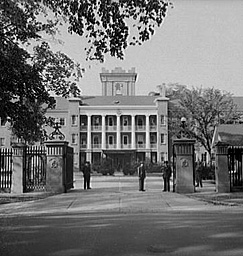industrialization & immigration
The Springfield Armory
The Springfield Armory played a key role in the western Massachusetts uprising known as Shays' Rebellion. Daniel Shays and other disaffected farmers led an insurrection in 1787 and marched on the Armory with the objective of seizing barracks, cannons, muskets and ammunition. The plan was intercepted before Shays and his men carried out their raid. Concerns about further potential insurrections forced leading political figures to call for a convention to strengthen the Articles of Confederation under which the former colonies were governed. The convention in Philadelphia subsequently produced the Constitution of the United States.
The Armory provided both a location for the development of new technologies and employment opportunities for successive waves of migrants and immigrants to the Connecticut River Valley. Manufacturing facilities at the Armory originated new techniques in mass production and the use of interchangeable parts. Craftsmen and merchants in workshops and supply houses throughout the region relied upon operations at the Armory in a mutually beneficial exchange of labor, skills and technology. During nearly 175 years of production, the Armory manufactured increasingly sophisticated types of shoulder arms, from single-shot flintlock muskets to breech-loading, bolt-action and repeating rifles, to the semi-automatic M1 developed by John Garand in the 1920s.
Irish and other western European immigrants dominated the workforce at the Springfield Armory during the nineteenth century, but by the early 1900s eastern European immigrants were arriving in large numbers to fill semi-skilled or low-skilled positions. The Great Migration brought increasing numbers of African Americans to the area in search of opportunities outside of the Jim Crow South. Mechanization and the drive to lower costs allowed employers in many instances to favor women and African-American workers over higher-paid, skilled workers. During both World War I and World War II, immigrant women and blacks took positions left vacant by men fighting in the conflicts overseas. Forty percent of the workforce at the Armory during World War II was female. The demands of wartime production also provided steady work and improved wages for African-American workers, and many developed skills that facilitated upward social mobility after the war.
Workforce numbers and production at the Springfield Armory peaked during World War II. The Armory was closed in 1968, and is now operated by the National Park Service as the Springfield Armory National Historic Site, located on the site of Springfield Technical Community College. There one can enjoy exhibits and artifacts attesting to the crucial role the Armory played in the political, economic and social life of the United States and the Connecticut River Valley.